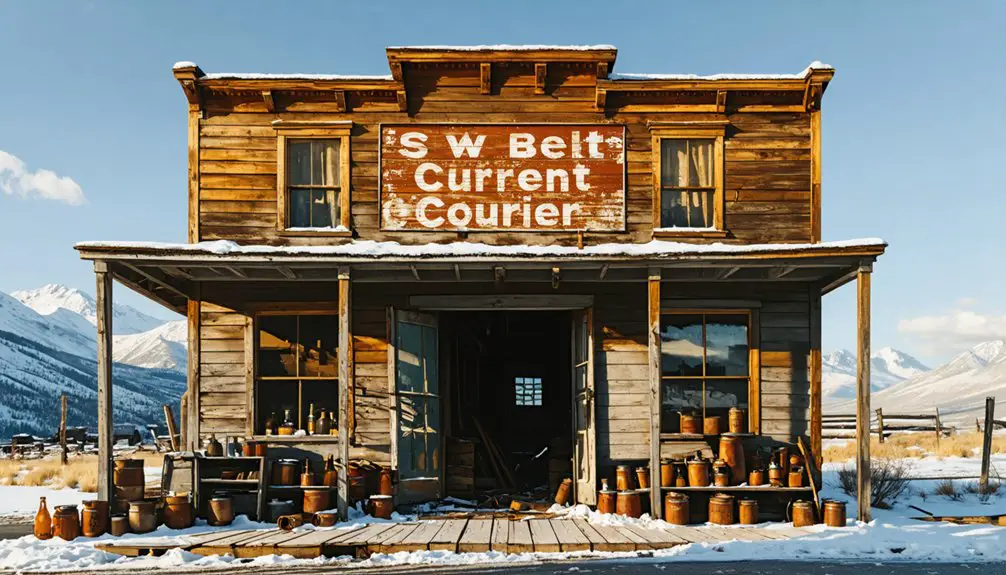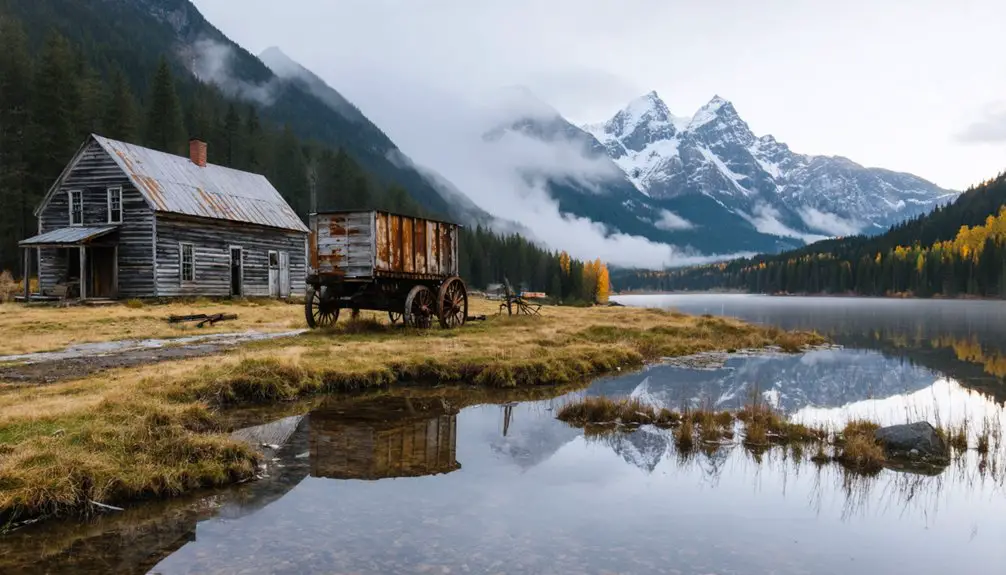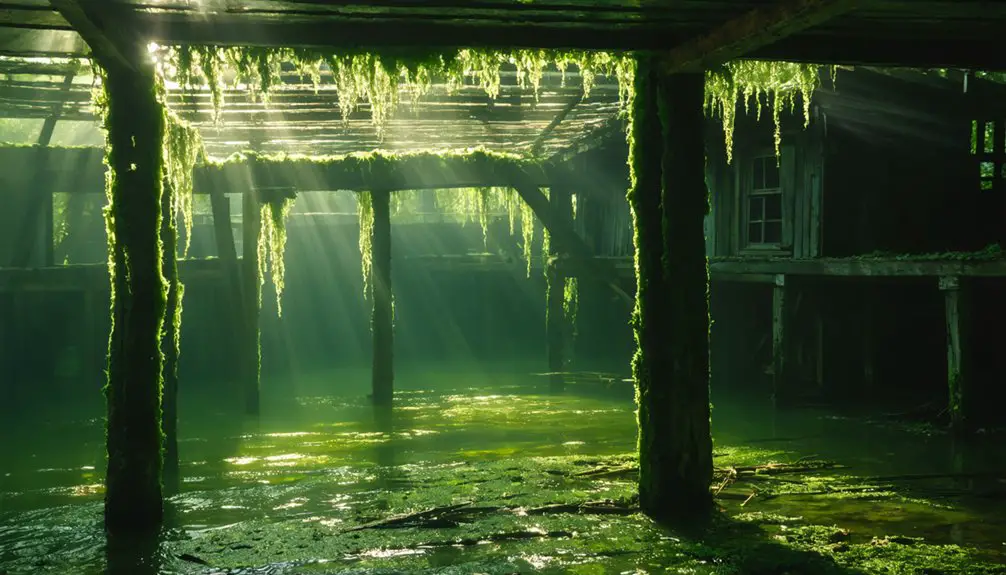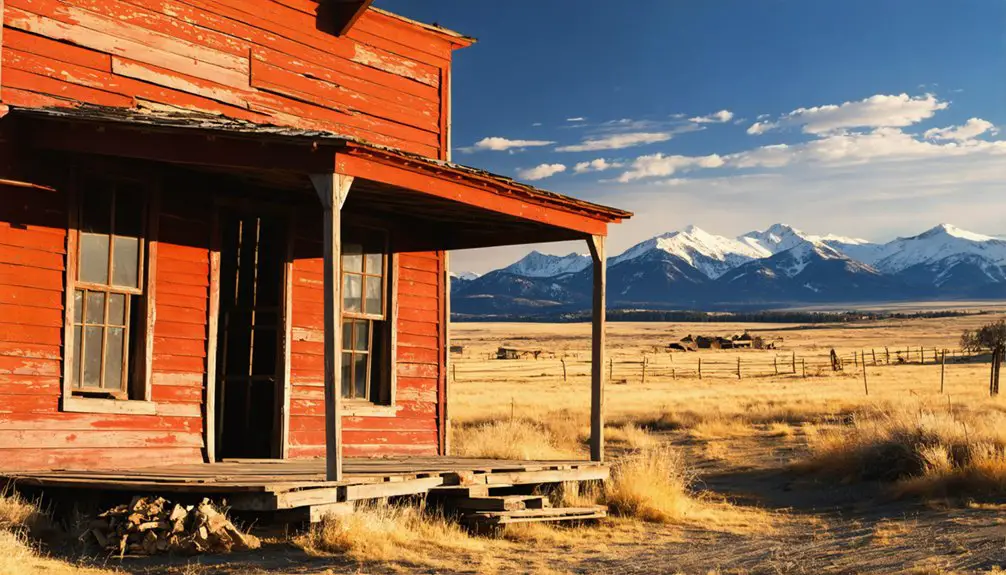You’ll find the ghost town of Alton submerged beneath Montana’s Sherburne Lakes, where it once thrived as a copper mining boomtown from 1898 to 1902. Originally named Altyn after financier David Greenwood Altyn, the town boasted 600-800 residents, a newspaper, and impressive mining operations including a 1,300-foot tunnel. The creation of Sherburne Dam between 1914-1921 flooded the town’s remains, leaving a mysterious underwater time capsule of Montana’s mining heritage.
Key Takeaways
- Alton began as a copper mining boomtown in 1898 after ore discovery near Cracker Lake, reaching a population of 600-800 residents.
- Originally named Altyn after financier David Greenwood Altyn, the town featured advanced mining technology including a 1,300-foot tunnel.
- The town thrived briefly during Montana’s mining era but declined due to resource depletion and harsh environmental conditions.
- Sherburne Dam’s construction between 1914-1921 submerged most of Alton’s buildings and streets underwater, preserving its remains.
- Now listed on the National Register of Historic Places, Alton’s underwater ruins include a two-story hotel and mining tunnel systems.
The Rise of a Mining Boomtown
When prospectors discovered copper ore near Cracker Lake in 1898, they triggered a rapid transformation that would establish Alton as Montana’s newest mining boomtown. Following earlier gold rushes in Deer Lodge, Bannack, and Helena, this copper discovery drew both national and international investors to the region.
You’d find the town, originally named Altyn after financial backer David Greenwood Altyn, quickly growing to house 600-800 residents between 1899 and 1902. The mining technology of the era was impressive – workers constructed a 1,300-foot tunnel and hauled a massive 16,000-pound concentrator through mountainous terrain. The twelve sturdy mules pulled the heavy equipment across 275 miles from Fort Browning. The area achieved recognition when it received a diploma for oil at the 1905 State Fair.
The boomtown culture flourished as saloons, hotels, a post office, and even a newspaper emerged to serve the bustling mining community, while the Swift Current Courier boldly proclaimed the town’s assured growth.
Life in Early 1900s Altyn
You’d find the daily rhythm of Altyn centered around the demanding work of mining, with miners trudging to their claims each morning and returning exhausted to their cabins and tents each evening.
After work, you’d see these hardy souls gathering at one of the town’s saloons, which served as essential social hubs where miners could share stories, conduct informal business, and find brief respite from their grueling labor. Just as the workers at the Milwaukee Railway Station would gather at their crew quarters after long shifts on the rails. Much like the pioneering photographer L.A. Huffman who documented life in early Montana, these workers were part of the territory’s dramatic transformation.
If you’d visited the town’s general store, hotel, or newspaper office, you’d have encountered a mix of local residents and traveling investors, all hoping to strike it rich in this mountain frontier settlement.
Daily Rhythms and Work
Life in early 1900s Altyn revolved around the demanding rhythm of mining operations, with workdays beginning at dawn‘s first light around 5-6 AM. You’d find yourself working 10-12 hour shifts in the mines, followed by essential secondary tasks like equipment maintenance or tending to livestock. Much like Butte’s “Richest Hill on Earth” miners during the same period, the work was grueling but potentially lucrative.
Work-life balance meant maximizing daylight hours, as artificial lighting was scarce. Your home life centered around a single wood or coal-burning stove for cooking and heating. The women of Altyn relied heavily on skilled immigrant midwives for childbirth and healthcare needs within their isolated community.
While men tackled mining duties, women managed households, provided healthcare, and fostered community resilience through shared labor and resources. You’d rely on walking or horseback for transportation, with occasional rail access for supplies.
The harsh Montana climate shaped your daily patterns, requiring careful planning and cooperation with neighbors to survive and thrive.
Mining Town Social Scene
The bustling social scene in early 1900s Altyn centered around several key establishments that served as essential community hubs.
You’d find most social gatherings happening at the town’s saloons, where miners and transient residents gathered for drinks, gambling, and casual entertainment. The hotel doubled as both lodging and a meeting spot, while the general store became a natural place for catching up on local news and gossip. Like Montana’s historic Bannack mining camp, these gathering spots played a vital role in community life.
With a population that fluctuated between 600 to 800 people during its peak years of 1899-1902, these venues created a tight-knit community despite the town’s temporary nature. Similar to other mining towns like Garnet which had thirteen saloons during its heyday, Altyn’s social venues were plentiful.
You could get your news from the Swift Current Courier when it briefly ran, or more commonly through word-of-mouth at the post office and local establishments.
The Legacy of David Greenwood Altyn
Despite his mining ventures ultimately failing, David Greenwood Altyn left an indelible mark on Montana’s landscape through his substantial financial investments in the Cracker Lake Mine region during the late 1890s. His ambitious vision transformed the wilderness into a bustling community, even if only briefly. Reports of gold, silver, copper, and lead drew thousands of prospectors to the area in 1889.
Altyn’s investments established crucial infrastructure including a sawmill, steam-driven concentrator, and a 1,300-foot mining tunnel. The nearby prominent mountain peak stands as a permanent geographical monument to his influence in the region.
- You’ll find his name immortalized in local geography, particularly Altyn Peak
- His financial backing created a boomtown supporting up to 800 residents
- The town boasted modern amenities like a post office, hotel, and newspaper
- His total regional investment would equal roughly $43 million in today’s dollars
Though the mines proved unviable by 1902, Altyn’s legacy endures as a symbol to the untamed spirit of Montana’s mining era.
Daily Operations and Commerce
During its peak years, Alton’s bustling commercial district served roughly 800 residents through a network of essential businesses, including a general store, hotel, post office, and several saloons.
You’d find miners stopping by the general store to stock up on supplies before their shifts, while others gathered at the saloons after work, fostering crucial community interactions that helped residents cope with the harsh mining life.
The town’s economic fluctuations directly impacted daily commerce, with business activity rising and falling alongside gold prices and mining success.
Like the tides of fortune, Alton’s commerce ebbed and flowed with every rise and fall in mining profits.
While the newspaper office kept everyone informed of local happenings, merchants adapted their operations to serve both permanent families and transient workers, creating a dynamic commercial environment that reflected the boom-and-bust nature of frontier mining communities.
The Swift Current Courier Years

While Altyn’s economic pulse quickened in 1900, the Swift Current Courier emerged as the town’s primary news source, capturing the zeitgeist of this bustling mining community through its limited but impactful run.
You’ll find the newspaper’s influence reflected in its enthusiastic reporting of local events and economic optimism, particularly its coverage of Sam Somes’ oil discovery that attracted $1.5 million in backing.
- The Courier shaped community identity by connecting 600-800 residents through shared news and aspirations.
- Mining prospects and boomtown culture dominated its headlines, fostering investor confidence.
- Its reporting on transient prosperity exemplified the typical Western frontier narrative.
- The single surviving issue holds historic significance as a rare glimpse into Montana’s early mining towns.
The paper’s brief existence paralleled Altyn’s own meteoric rise and fall, preserving the town’s fleeting golden age in print.
Natural Forces and Abandonment
As relentless natural forces laid siege to Alton’s structures throughout the 1940s, the town’s fate became increasingly sealed by a perfect storm of environmental challenges.
You’ll find that natural decay took hold as seasonal weather fluctuations and harsh Montana winters wreaked havoc on buildings through devastating freeze-thaw cycles. The climate impact proved particularly brutal, with spring floods eroding foundations while summer droughts crippled both water supplies and mineral processing operations.
The depletion of mineral resources dealt the final blow, as soil instability from abandoned mines made the area unsafe for habitation.
You can still see how wildlife reclaimed the landscape, while windstorms and vegetation growth steadily consumed what remained of the town’s infrastructure. Without resources to combat these natural forces, Alton’s remaining residents had little choice but to depart.
Beneath Sherburne Lakes

If you visit Sherburne Lakes today, you won’t see any trace of Alton’s once-bustling streets and buildings, as they rest beneath the waters that flooded Cracker Flats valley.
The creation of Sherburne Lakes submerged the abandoned mining town‘s remains, including its post office, general store, saloons, and hotel that had served nearly 800 residents during the copper mining boom of 1899-1902.
While the underwater ruins hold fascinating historical value, park regulations prohibit direct exploration of the submerged ghost town site, leaving Alton’s physical remnants accessible only to the lake’s depths.
Underwater Mining Town Remains
Beneath the tranquil waters of Lake Sherburne lies the submerged mining town of Alton, once a bustling copper mining settlement in Montana’s Many Glacier Valley.
The underwater archaeology reveals a fascinating glimpse into early 20th-century mining life, with submerged structures including a two-story hotel and extensive mine shafts stretching over 1,300 feet underground.
You’ll find these remnants of Alton’s mining legacy beneath the reservoir:
- Complex tunnel systems that once yielded valuable copper deposits
- The foundations of Sam Somes’ hotel, a hub of local commerce
- Mining infrastructure that led to unexpected oil discoveries
- Underground passages that park authorities now restrict for safety
The flooding from Sherburne Dam’s construction between 1914 and 1921 preserved this slice of Montana’s mining history beneath its waters.
Lake Formation History
While glaciers sculpted Montana’s landscape during the Pleistocene epoch, they laid the foundation for what would become Sherburne Lakes.
You’ll find evidence of powerful glacial influences from the Des Moines lobe and its Grantsburg sublobe, which overrode older St. Croix moraine deposits to shape the terrain you see today.
As these massive ice sheets melted, they created proglacial lakes trapped behind highland barriers.
The resulting sediment stratification tells a story of fluctuating water levels and repeated glacial advances. Fine to medium-grained sands settled in these calm waters, forming the New Brighton Formation that lies beneath the lakes.
Modern groundwater patterns continue to shape these basins, which emerged from a complex interplay of ice movement, meltwater drainage, and strategic highland placement.
Exploring Submerged Ruins Today
The submerged remnants of Altyn now rest beneath Lake Sherburne’s whitecapped waters, a monument to Montana’s evolving landscape.
While you can’t readily see the town’s remains through the often-turbulent surface, historical significance lies in the foundations near Cracker Flats at the base of Mt. Wynn and Mt. Allen.
For those interested in submerged exploration, here’s what you’ll need to know:
- Visibility of ruins depends heavily on water clarity and reservoir levels
- Most structures have been erased, with only foundations remaining on higher ground
- No official diving programs exist due to safety and preservation concerns
- Your best views come from hiking the surrounding trails and studying historical documents
The area remains a reflection of Montana’s mining heritage, though access to the underwater ruins stays limited by natural and regulatory conditions.
Exploring Montana’s Underwater Ghost Town

Hidden beneath the waters of Alton Lake lies a remarkable piece of Montana history – the submerged ghost town of Alton. While you can’t stroll down its streets like other Montana ghost towns, underwater archaeology reveals the town’s preserved remnants from its mining and logging heyday.
The flooding from Noxon Rapids Dam in 1959 transformed this once-bustling settlement into an underwater time capsule.
If you’re an experienced scuba diver, you’ll find building foundations and artifacts resting on the lake bed, though visibility remains challenging.
Ghost town exploration here requires specialized equipment and proper permits, as the dam company restricts access. While commercial tours aren’t available, the submerged ruins continue to intrigue historians and adventurers seeking to discover Alton’s underwater secrets.
Historical Preservation Challenges
Despite its protected status on the National Register of Historic Places, Alton faces significant preservation hurdles that threaten its historical legacy.
You’ll find preservation strategies hampered by Montana’s harsh climate, while funding challenges create barriers to maintaining the town’s authentic character. Multiple agencies must coordinate their efforts, making quick action difficult when deterioration threatens historic structures.
- Limited winter access prevents year-round maintenance work
- Mining hazards and unstable ground restrict preservation activities
- Fluctuating tourism revenue impacts available preservation funds
- Strict historic preservation laws complicate restoration efforts
The Montana Ghost Town Preservation Society relies heavily on volunteers and donations to protect Alton’s remaining structures, but without consistent funding, the battle against time and weather continues to challenge preservation efforts.
Frequently Asked Questions
What Indigenous Tribes Inhabited the Area Before Alton Was Established?
You’ll find the Blackfeet and Crow were the primary Native tribes in this region, with Assiniboine and Gros Ventre also having historical impact through their hunting grounds and settlements nearby.
Were Any Major Crimes or Notable Lawlessness Reported in Alton?
Like shadows in forgotten mines, you won’t find major documented crime history in this town. While mining settlements often faced lawlessness, Alton’s sparse records don’t reveal notable law enforcement incidents.
Did Any Famous Personalities or Celebrities Ever Visit Alton?
You won’t find any records of famous visitors or celebrity sightings in this small mining town. Historical documents don’t mention any notable personalities visiting during its brief existence from 1899-1902.
What Happened to the Residents After the Town Was Abandoned?
You’ll find most residents relocated to nearby settlements like Babb and St. Mary, while others sought mining work elsewhere. The economic impact forced many to switch to farming, ranching, or railroad jobs.
Are There Any Surviving Photographs of Alton During Its Peak?
You won’t find concrete historic documentation of Alton’s glory days – no surviving photographs from its peak have been discovered in major archives or collections, leaving this chapter of visual evidence mysteriously blank.
References
- https://www.legendsofamerica.com/mt-bannackghost/
- https://www.parkcabinco.com/blog/2019/1/3/the-drowned-town-of-altyn
- https://www.garnetghosttown.org/history.php
- https://avrextravel.com/montana-ghost-towns/
- https://www.youtube.com/watch?v=W-JO5JV-oZU
- http://hikinginglacier.blogspot.com/2020/04/the-cracker-lake-mine-and-boom-town-of.html
- https://ilmineswiki.web.illinois.edu/wiki/Category:Alton-Quadrangle
- https://archiveswest.orbiscascade.org/ark:/80444/xv28731
- https://www.youtube.com/watch?v=2mPTYEJtKFQ
- https://www.albertonmontana.com/history.htm



